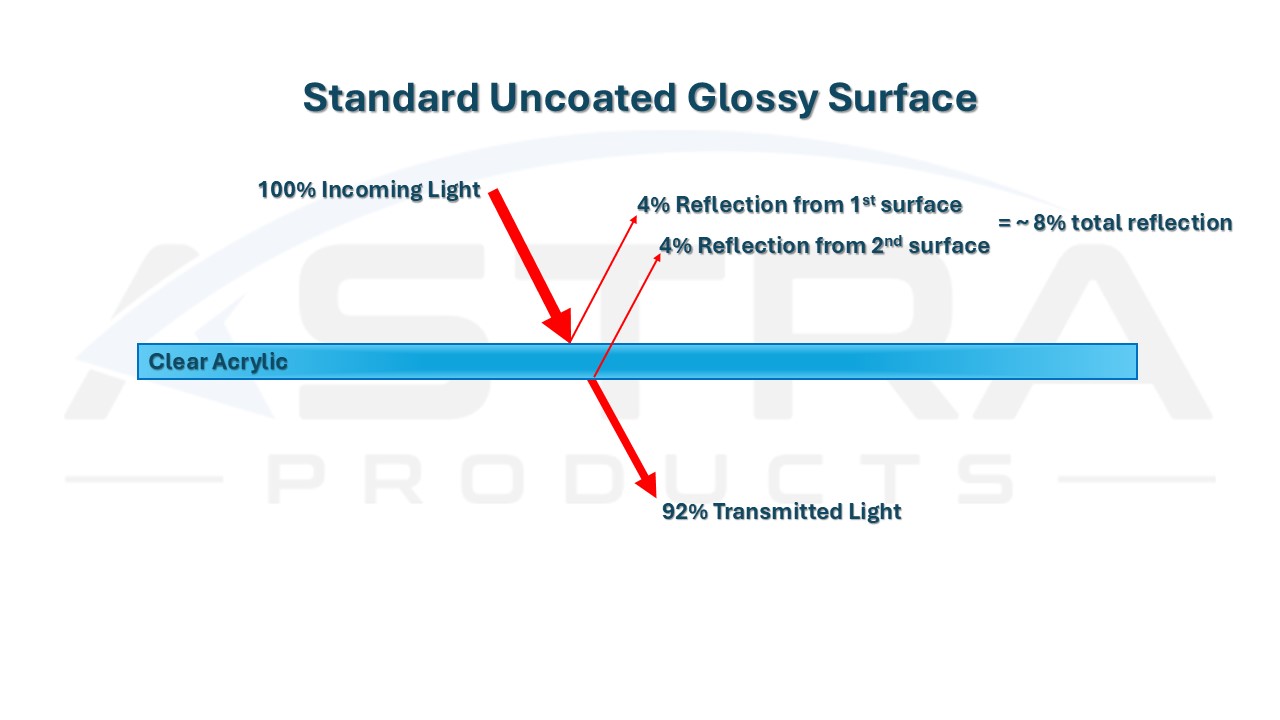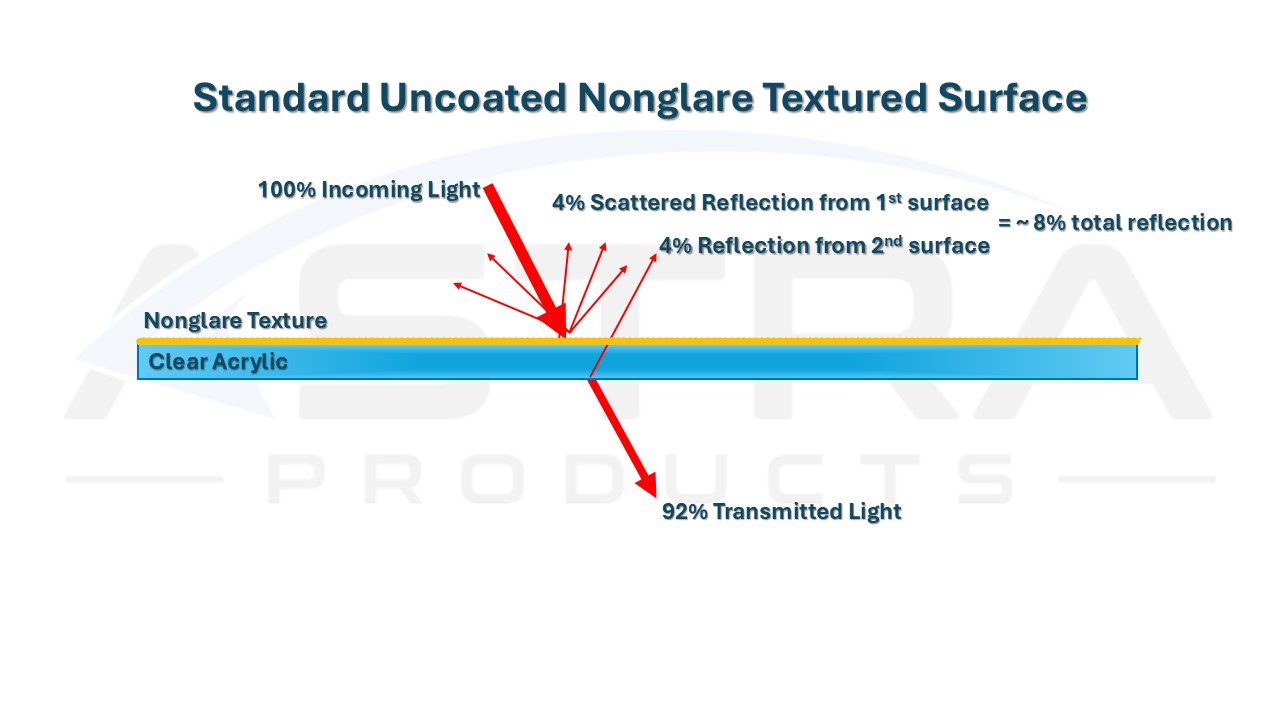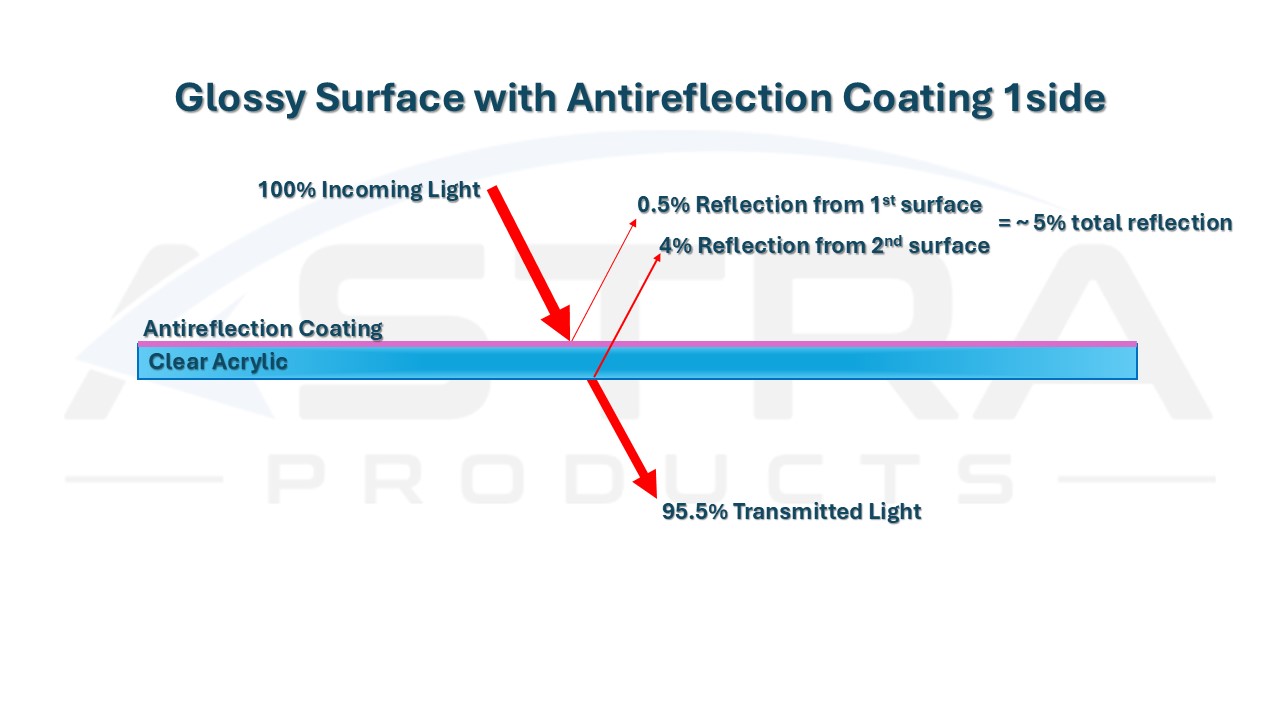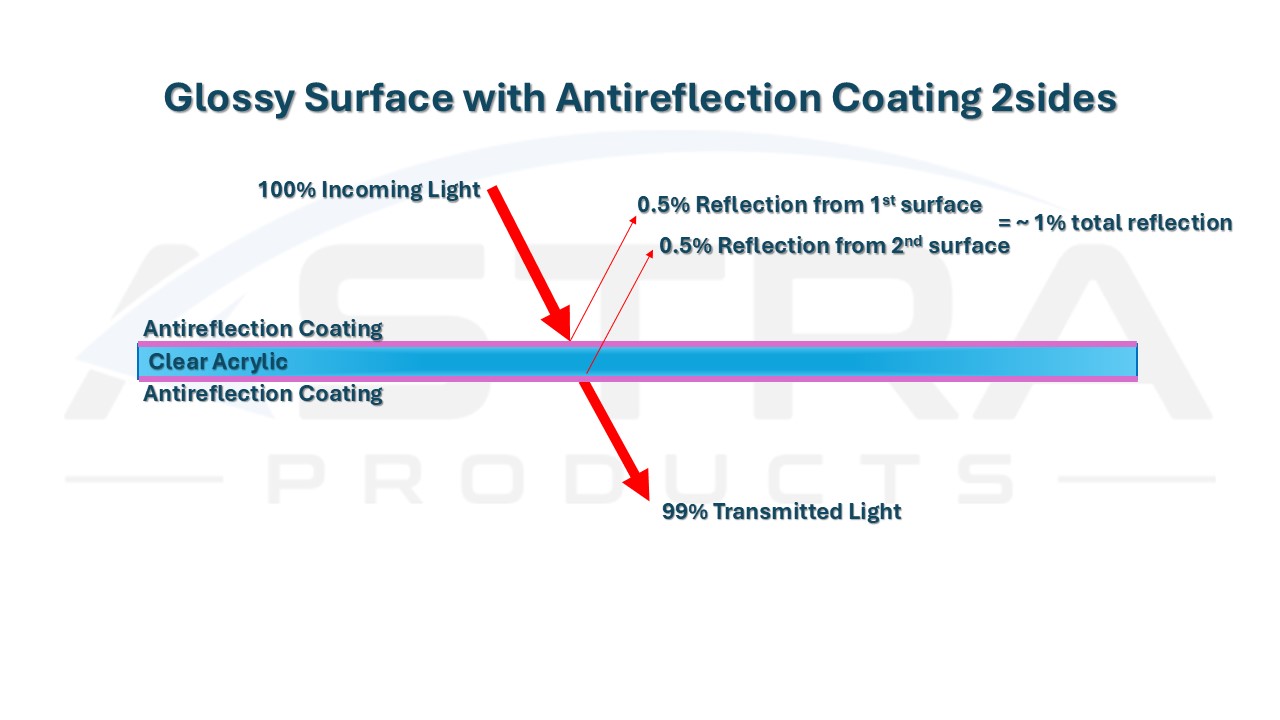Non-Glare Textures vs Anti-Reflective Coatings
Differences Between Non-Glare Textures & Anti-Reflective Coatings on Acrylic
There can be some confusion when considering the different options available for dealing with reflections and glare from your optical filter/window. First things first:
Where are the reflections coming from?
In simple terms, reflections occur any time light crosses a boundary between materials or mediums, some percentage of the light will be reflected. The percentage reflection is mainly dependent on the change in the Index of Refraction between the two mediums. The greater the delta, or difference between the two materials, the higher the percentage of light is reflected instead of transmitted.
Consider one of the most common scenarios we see at Astra Products:
Light traveling through air (with an index of refraction of 1.00), going through a thin piece of clear uncoated acrylic (with an index of refraction of 1.49), and then back into air again.
The light is going through two boundaries: air to acrylic and acrylic to air. Each of these boundaries will reflect back some percentage of light. Here’s what that looks like in practice:

- Approx. 92% of the light passes through the acrylic
- The remaining 8% is reflected back (4% at each surface)
If this piece of acrylic is in front of your display in a dimly lit area, that 8% reflection of the ambient lighting may go unnoticed. But in outdoor or high-brightness environments, the same 8% being reflected back could significantly reduce visibility or add a distracting glare!
What options are available for managing reflections on acrylic?
We have two main options available within our product lines for dealing with reflections.
Option 1: Non-Glare Textured Surfaces
At Astra Products, we refer to this option as non-glare (NG). But there are several common terms used in the industry, like reduced glare (RG), anti-glare (AG), matte, textured, and more.
Some may also say anti-reflection or AR, and that is where things get confusing for us, because we consider anti-reflective coatings something entirely different (more on that below).
What they are all referring to is a textured surface that scatters/diffuses the reflected light. Instead of getting a mirror/specular reflection from a glossy surface, the reflection from a textured surface is hazy and typically less distracting to the viewer. The image below gives an example of what is happening:

Note that the percentage of total reflected light is the same 8% as the percentage from the glossy sheet. The difference is that some of the reflections are scattered.
Non-glare textures could be categorized by their Gloss Value. This is basically a ratio of the percentage of light reflected directly back at the source versus the percentage of diffused light reflections. The lower the Gloss Value, the higher the percentage of diffused reflected light. CLAREX offers non-glare textures ranging from a Gloss Value of 3, which is a very heavy texture used for diffusers, up to a Gloss Value of 118 on the smooth/glossy sheets. For display windows, customers usually opt for Gloss Values around 50.
Learn more about CLAREX Non-Glare textures
The textured surfaces do impart a haze. If you hold up a piece of non-glare material and look through it, you will notice a haze. The severity depends on the texture; typically, the lower the Gloss Value, the more hazy it will be. It also depends on the gap between the non-glare filter and what is behind it. If it’s right up against your display with minimal gap, then the haze largely goes away. Check out the video below for an example.
Option 2: Optical Coatings
Thin optical coatings can be applied to the surface of the acrylic sheets to reduce the reflections. We refer to these coatings as anti-reflection, anti-reflective, or AR coatings.
In simple terms, the anti-reflective coatings are messing with that air/plastic boundary layer and turning the reflected light back around. This has two mutual benefits:per reduced reflections and increased transmission. Unlike the non-glare textures, the anti-reflective coatings do not create any haze.
If you apply an anti-reflective coating to one side, you will address the reflections on one side. That cuts total reflections by about half. What you lose in reflections, you gain in transmission. See below:

Not bad. If you add an anti-reflective coating to both sides to minimize the percentage of total reflections. See below:

With anti-reflective coating on both sides, the clear acrylic is getting close to invisible!
Key considerations for anti-reflective (AR) coatings:
- AR coatings must be the outermost layer for them to work properly.
- They go on top of the hard coat. This can leave them susceptible to damage from handling and the elements.
- AR coatings don’t perform well if they get dirty.
- AR coatings are hydro/oleophilic, meaning they tend to attract water, oils, and dirt. To help with this, Astra offers optional anti-smudge, hydro/oleophobic coatings that help prevent smudges and make surfaces easier to clean.
- AR coatings perform best across a limited range of wavelengths.
- AR coatings are designed to minimize reflection at specific wavelengths. Standard coatings perform best around 550nm, which is about the middle of the visible range (~400-700nm). Their effectiveness starts to decrease as you move up/down from 550nm, and may increase reflectivity outside that range (below 375nm or above 800nm). Custom-tuned coatings are available for specialized applications, such as our AR coatings tuned for NIR applications.
- AR coatings are a premium option.
- AR coatings are typically made up of several ultra-thin layers applied in a vacuum chamber, which makes them a higher-cost solution. However, for applications where optical clarity and performance matter most, they deliver unmatched results.
learn more about CLAREX Anti-Reflective coatings
Choosing Between Non-Glare (NG) & Anti-Reflective (AR) Options
There are a lot of factors to consider when trying to decide. So, how should you choose which option to use?
Selecting the right optical surface treatment depends on your specific application and environment. Below are some common use cases and guidance on which option may be the best fit:
- Protective Window for an Indoor Display
- NG materials typically perform well for indoor displays, especially when the gap between the window and display is minimal.
- Note: If a glossy front surface is required for aesthetic or technical reasons, NG is not suitable.
- Protective Window for an Outdoor Display
- When dealing with direct sunlight, AR coatings are typically required to minimize reflections and ensure visibility.
- NG can also work in some outdoor applications but can become washed out in bright sunlight.
- Tip: NG and AR coatings can be combined for maximum outdoor performance.
- Protective Window for a Camera or Sensor
- AR coatings are essential for optical clarity in camera and sensor applications. NG textures can introduce haze and reduce image quality, making them unsuitable for this application.
- Cost-Sensitive Projects & Applications
- If the application allows, choosing NG over AR can provide significant cost savings than if they were AR-coated.
- Applications Requiring Maximum Light Transmission
- AR coatings should be used for applications where optimal light transmission through the material is critical.
- Harsh Environmental Conditions
- In rugged or abrasive environments, exposed AR coatings may degrade or delaminate over time.
- A hard-coated, NG surface is more robust, offering better durability and long-term reliability.
Not sure which option to choose?
We get it. It’s a lot of info to digest. We’re here to help. Please reach out to discuss which options would be best for your specific application.